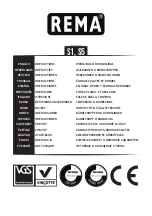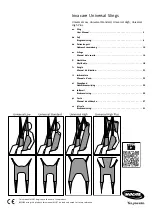
When selecting the websling/roundsling, the working
load limit of the websling/roundsling has to be consid-
ered, based on the way of use and on the load to be
lifted.
The selected websling/roundsling has to be both long
and strong enough for the load to be lifted
In the case of a combined use of webslings/round-
slings and end fittings and/or lifting devices, make sure
that these are compatible with the slings.
Solutions of harmless acids and/or alkalis can become
concentrated by evaporation and cause damage to the
websling/roundsling. Do not use damaged webslings/
roundslings anymore. Polyester webslings/round-
slings are resistant to mineral acids, but affected by
alkalis. Polyamide webslings/roundslings are resistant
to alkalis, but affected by mineral acids.
Webslings/roundslings may only be used in the tem-
perature range of -40°C and +100 °C.
Only use webslings/roundslings with a clearly legible
label.
Avoid damage to the label by the hook, the load or the
winding when lifting in choke hitch.
Never overload the webslings/roundslings and only
use the slings according to tabel 1.
Make sure the webslings/roundslings do not become
knotted or twisted.
Protect the websling/roundsling against cutting and
friction by using selvedges.
Secure the webslings/roundslings so that the load
cannot fall out. Make sure that the hoisting point lies
over the centre of gravity so that the load is balanced.
Otherwise the lifted load might fall out of the web-
sling/roundsling.
When webslings/roundslings are used in basket hitch,
the load should be secured well, as with this kind of
lifting the load is not grasped like in choke hitch. When
webslings/roundslings are used in pairs, the use of a
spreader is recommended. When lifting with one or
more webslings/roundslings, the vertical angles as
shown in tabel 1 have to be followed. These figures are
based on practical experience and calculations of the
forces developing when lifting asymmetrically.
When using several webslings/roundslings, make
absolutely sure that no websling/roundsling is over-
loaded and that the weight is evenly distributed on
the load.
Avoid snatch or shock loading.
Do not drag the load into the websling/roundsling. Do
not drag the websling/roundsling over the ground or
rough surfaces.
Never allow the load to rest on the websling/round-
sling, if this could cause damage to the websling/
roundsling.
Make sure that the websling/roundsling does not get
jammed and never try to pull a websling/roundsling
from beneath the load.
After use, webslings/roundslings should be stored in a
dry and well ventilated place, away from any source of
heat(direct sunlight).
Webslings/roundslings should never come into con-
tact with hot surfaces or gases (i.e. lamps, flames).
Before use, webslings/roundslings should be exam-
ined for defects, the side stich and the end fittings.
Never use defective webslings/roundslings.
Webslings/roundslings and end fittings which due to
damaging show notches, gleaming surfaces or chafed
patches, must not be used anymore. A competent
person then has to judge whether the particular web-
sling/roundsling can be used without any risk after
being repaired.
Chemical active environments may result in local
weakness and softening of the fabric. This is indicated
by flaking of the surface fabrics, which can be plucked
or rubbed off. Such webslings/roundslings must be re-
1
2
3
4
5
6
7
8
9
10
11
12
13
14
15
16
17
18
19
20
21
22
moved from service.
Only the manufacturer himself or persons who have
been instructed by the manufacturer should repair
the webslings/roundslings. Only webslings/round-
slings, who can be identified by their label, may be
repaired.
Webslings/roundslings contaminated by acids and/or
alkalis have to be rinsed in water or another suitable
solvent such as trichloroethylene or carbon tetrachlo-
ride. Follow the safety instructions of those solvents
carefully.
In some cases it may be necessary to ask the manufac-
turer himself for a suitable cleaning procedure.
Webslings/roundslings that have become wet in use
or as the result of cleaning, should be hung up and
allowed to dry naturally. Under no circumstances
should slings be heated or otherwise force-dried.
When lifting the websling/roundsling in choke hitch,
the natural angle (1) (see fig. 2) should not be wider
than 120°. Never try to force-pull the point of the
choke hitch. Figure 2 shows the correct way of lifting a
websling/roundsling in dubble choke hitch.
Webslings/roundslings with a weight of more than 18
kg, that are transported regularly, have to be carried
with a special carrier wagon or by more than one per-
son.
Webslings/roundslings may only be used for lifting
purposes.
Persons are not allowed to stay under the load.
When lifting with the websling/roundsling make sure
that the loading is uniform across their width.
Webslings/roundslings should be placed on the load
such as stitchings are not over the hook or around the
load.
The, by polyester webbing reinforced, eye-length of
the webslings should not be less than 3.5 x the max-
imum thickness of the hook and the angle formed in
the eye of the sling should not exceed 20°. When us-
ing end fittings, the part of the lifting appliance which
bears on the sling slould be essentially straight en not
smaller than the eye or the sling. If the bearing width
of the sling is not more than 75 mm, the curvature or
radius of the lifting appliance attachment should be at
least 0.75 x the bearing width of the sling.
23
24
25
26
27
28
29
30
31
32
33
INSTRUCTIONS
(EN 1492-1, EN 1492-2)
WEBSLINGS & ROUNDSLINGS
ENGLISH
NEDERLANDS
INSTRUCTIES
(EN 1492-1, EN 1492-2)
HIJSBANDEN & RONDSTROPPEN
Bij de keuze van de hijsband of rondstrop dient men
rekening te houden met de maximale toelaatbare
werklast van de hijsband/rondstrop, uitgaande van de
gebruikswijze en de te hijsen last.
De gekozen hijsband/rondstrop moet voor de te hi-
jsen last sterk en lang genoeg zijn.
Indien men een hijsband/rondstrop gebruikt in com-
binatie met aansluitmiddelen en/of hijsinrichtingen
moet men er zeker van zijn dat deze op elkaar zijn
afgestemd.
Oplossingen van zuren en/of alkaliën kunnen door
verdamping zo geconcentreerd worden dat ze schade
aan de band/rondstrop kunnen veroorzaken. Neem
verontreinigde banden/rondstroppen direct uit bed-
rijf. Polyester hijsbanden/rondstroppen zijn bestand
tegen minerale zuren maar worden aangetast door
alkaliën. Polyamide hijsbanden/rondstroppen zijn
bestand tegen alkaliën maar worden aangetast door
minerale zuren.
Hijsbanden/rondstroppen zijn alleen te gebruiken
tussen -40°C en +100°C.
Gebruik alleen hijsbanden/rondstroppen die voorzien
zijn van een leesbaar label.
Voorkom dat het label beschadigd wordt door bijv. de
haak, de last of d.m.v. omsnoering als men gestropt
gaat hijsen.
De hijsbanden/rondstroppen mogen niet overbelast
worden en men dient de hijsbanden/rondstroppen al-
leen te gebruiken zoals aangegeven in tabel 1.
Hijsbanden/rondstroppen mogen nooit geknoopt of
1
2
3
4
5
6
7
8
9
1

















